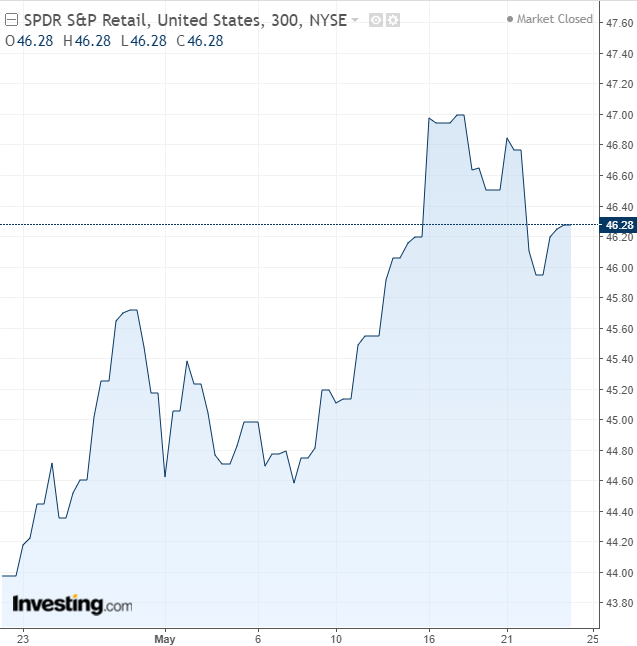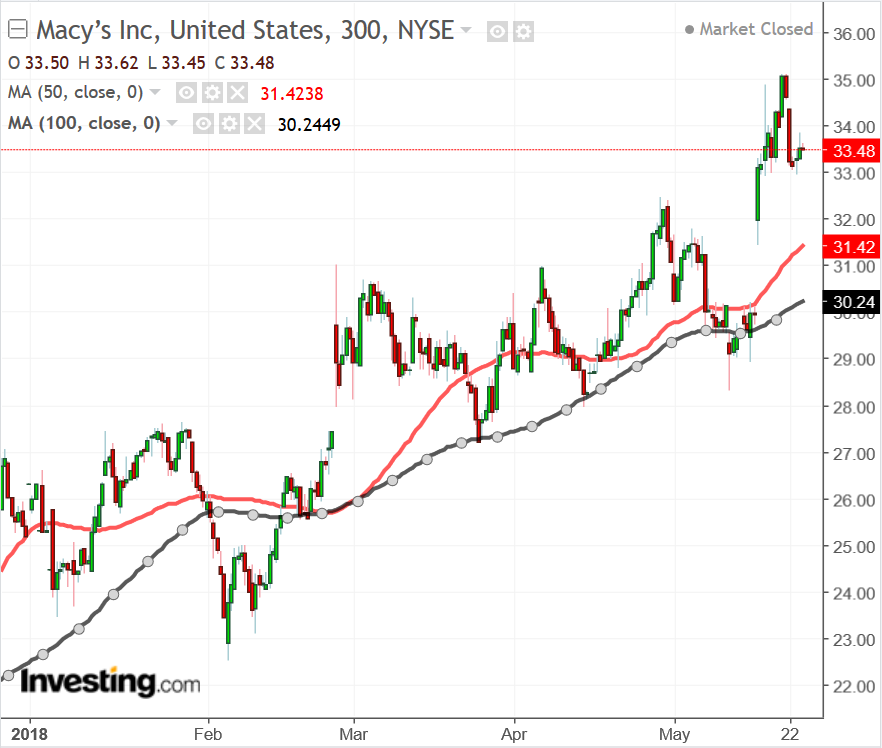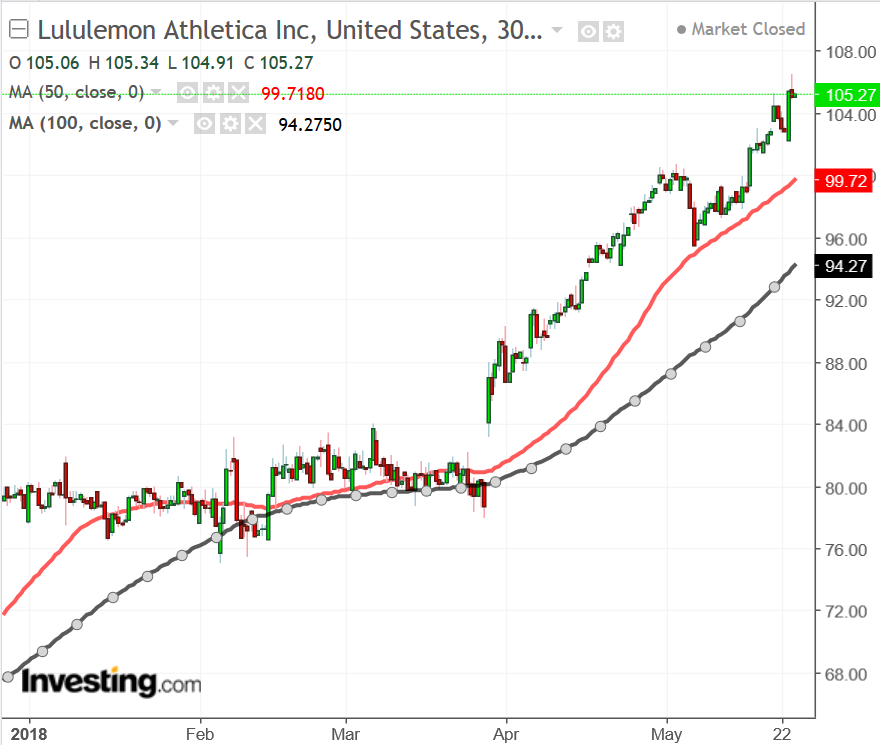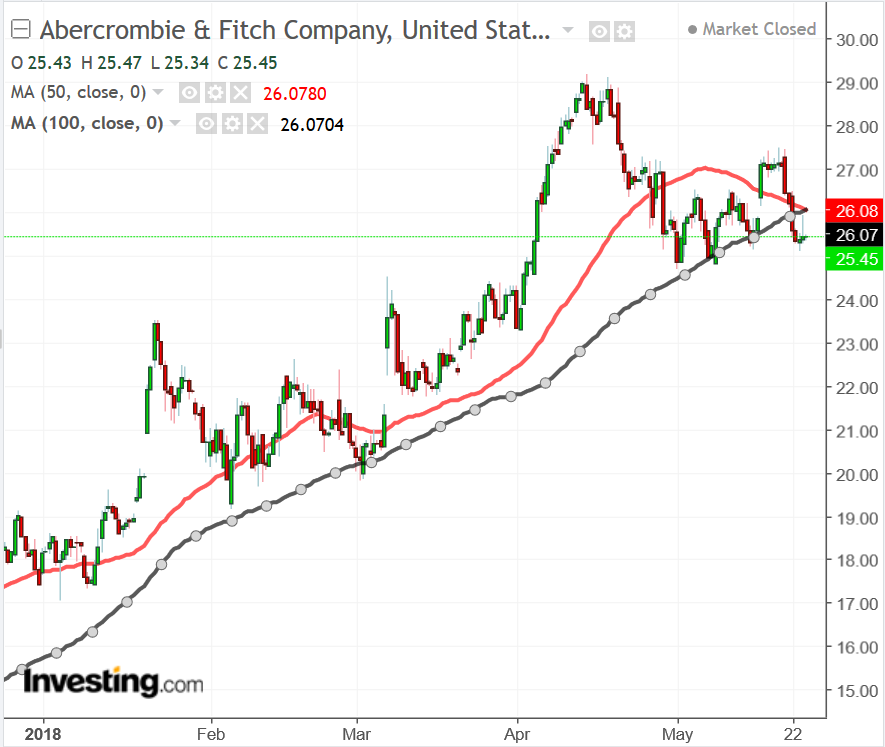Recent reports of the retail sector’s death have been greatly exaggerated. The sector's biggest exchange-traded fund—SPDR S&P Retail (NYSE:XRT)—last week managed to reach its highest level in almost four months.
Indeed, the sector has been in full-fledged recovery mode lately, even as analysts repeatedly warned of the demise of traditional bricks-and-mortar retailers, a result of the 'Amazon Effect' as consumers spend more and more time shopping online.

The SPDR S&P Retail ETF, which is up around 5% since the start of April, offers the most popular way to play the wider retail sector as it tracks a broad-based, equal-weighted index of 84 stocks in the sector.
Why The Recent Push Higher?
A strong jobs market, booming consumer confidence and higher take-home pay in the wake of US tax reductions are buoying American consumers' ability and willingness to spend.
“Households are in good spirits and are spending in the new season,” James Knightley, chief international economist at ING Bank, wrote in a recent note. “Employment is rising, wages are growing and tax cuts means there is more cash in people’s pockets.”
Commerce Department figures released on May 15 showed that US retail sales rose 0.3% in April, as bigger after-tax paychecks helped compensate for rising fuel costs, signaling consumer demand was off to a firm start this quarter.
Nine of 13 major retail categories showed advances last month, led by the biggest jump in sales at apparel stores since March of last year. Increased receipts were also evident at furniture merchants, building-materials outlets and department stores.
The results add to the expectation that consumer spending, the biggest part of the economy, will rebound from its first-quarter weak patch.
Another factor that has been aiding retail shares lately has been reduced concern that a trade war between the United States and China could break out imminently.
Since the possibility of a trade war came into focus, retail shares have been under pressure on worries that the goods they produce in China could become unsustainably expensive. If Chinese authorities made it too costly to produce goods there, US retailers could charge consumers for the difference.
But over the weekend, Treasury Secretary Steven Mnuchin said the US-China trade war was “on hold.” Investors took these comments as a sign that trade tensions between the world’s two largest economies would reach a market-friendly solution.
Finally, a favorable demographic shift is creating tailwinds for the sector and boosting consumer spending. Generation X and millennials, who represented around 70% of the US working population in 2015, are now entering their peak earning years.
3 Stocks Poised To Outperform
Many retailers are currently attracting strong buying interest, with speculators betting on a surge in US consumer spending, driven by tax cuts and receding trade tensions. This buying wave should continue into the third quarter, setting the stage for a mid-year rally that could lift many stocks in the sector to multi-year highs.
Below we take a look at three stocks poised to outperform in the months ahead. Our list includes one major department store, a yoga gear maker and a mall-based teen apparel retailer.
1. Macy's
After a two-year bear market, which prompted many to write off the sector completely, major department stores finally bottomed out in the fourth quarter of 2017, with Macy's (NYSE:M) leading the way back. The stock is up 32% year-to-date versus the S&P 500's 2% return.

The stock surged more than 10% on May 16, its best day since December 17, 2008, after Macy's reported better-than-expected quarterly and same-store sales, the result of strong international tourism spending, a new loyalty program and a greater assortment of products offered in stores.
The company said all three of its divisions — Macy's, Bloomingdale's and Bluemercury — exceeded expectations during the first quarter of fiscal 2018. “The quarter was good every month - in fact, every week,” Chief Financial Officer Karen Hoguet said on a call with analysts. “Spirits are up.”
That prompted the department store retailer to raise its full-year profit forecast. Chief Executive Officer Jeff Gennette said on the post-earnings call the company saw double-digit growth in its online business, which should bode well going into the latter half of the year.
Macy's just recently announced its acquisition of Story, a New York-based concept shop, and will be bringing on Story's founder, Rachel Shechtman, as "brand experience officer" to steer the company's creative strategy. The retailer is also in the midst of rolling out mobile checkout to all of its locations by year end and is adding a virtual reality shopping experience to some stores.
Wall Street firm Susquehanna raised its rating to positive from neutral for Macy's shares earlier this week, predicting the retailer will report earnings above expectations this fiscal year. "We now believe that Macy's has upside potential to conservative earnings guidance as the fundamental strength from current initiatives are carrying through, which should deliver a parade of beat-and-raise quarterly earnings reports though FY18," analyst Bill Dreher said in a note to clients on Monday.
Dreher raised his price target for Macy's shares to $43 from $25, representing 24% upside to Monday's close.
Traditional retailing may still be under pressure from online retailers such as Amazon (NASDAQ:AMZN), but Macy's results showed there's still plenty of hope for traditional outlets as the sector evolves and transforms itself.
2. Lululemon
Canadian athletic apparel maker Lululemon Athletica (NASDAQ:LULU) has been acting like a true market leader lately, rising even on days when the broader market pulls back. The stock, which is trading near all-time highs, has rallied as much as 34% since the company reported blowout earnings growth on March 27.

The yoga-gear maker posted a surprisingly robust fourth-quarter profit and forecast further growth in the first quarter, as strong sales from a revamped e-commerce platform and a surge of traffic at permanent and holiday pop-up stores drove results. Its next earnings release is on May 31 after the market close. Analysts expect the company to earn 46 cents per share on revenue of $616.3 million. The reported EPS for the same quarter last year was 32 cents on revenue of $520.3 million.
Lululemon, which popularized “athleisure wear” by turning pricey women’s yoga apparel into mainstream fashion, is currently continuing its CEO search following the abrupt resignation of Chief Executive Laurent Potdevin in February on undisclosed charges of misconduct. Chairman Glenn Murphy, who became executive chairman on Potdevin’s departure, said recently that the company has met with “a number of great candidates,” but so far no decision has been taken.
Investors don't seem too worried just yet though, as the stock continues to outperform its sports apparel rivals, including Nike (NYSE:NKE) and Under Armour (NYSE:UA).
Looking ahead, LULU, which historically has been a brand focused more on women, has so far been successful with its efforts to court more male shoppers. The company now has a sales goal of $1 billion for its men's apparel business (and $4 billion in total sales) by 2020, which should act as a growth engine going forward.
3. Abercrombie & Fitch
Teen retailer Abercrombie & Fitch (NYSE:ANF) has enjoyed an impressive turnaround recently, after the brand fell out of favor with mainstream consumers and e-commerce and fast-fashion took over the space.
The stock, which dropped below $10 in 2017, has made a solid comeback, climbing to nearly $30 per share a couple of months ago, trading at $25.45 as of last night's close. ANF shares have gained more than 21% since reporting fourth-quarter earnings and sales which beat expectations on March 7. Year-to-date, the stock is up about 45%.

The retailer reported net income of $74.2 million, or $1.05 per share, up from $48.8 million, or 71 cents per share, for the same period last year. Sales were $1.19 billion, up from $1.04 billion last year.
More importantly, same-store sales grew 9%, with lifestyle brand Hollister, which ANF owns, up 11% and the namesake brand up 5% for the quarter, the chain’s first quarterly comp-store sales gain in 23 quarters, stretching back to 2011. The turnaround can be attributed to Fran Horowitz, the 53-year-old executive who was named CEO in February 2017 after a successful stint at the company’s red-hot Hollister nameplate.
Horowitz is pushing forward with a marketing strategy that seems to be the opposite of the one used by Mike Jeffries, her predecessor as CEO, which was responsible for the sexualized image of the company. Under Horowitz, A&F launched a gender-neutral line for its kids stores.
The stores have also been revamped and are integrated with technology. The overpowering perfume, which used to permeate the stores, has also been modified to a fresher, cleaner fragrance.
Consumer perceptions of Abercrombie “have gone from negative to positive for the first time in several years,” Horowitz said on the March 7 earnings call, a bullish development which should bode well for the next few quarters to come. Its next earnings release is on June 1.
